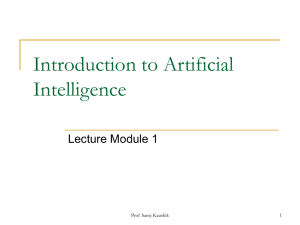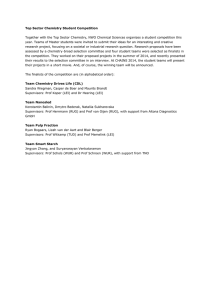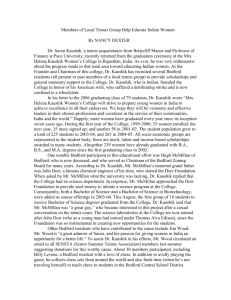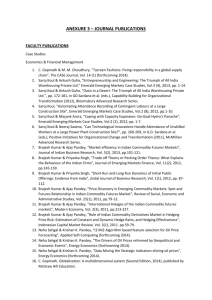What is AI?
advertisement
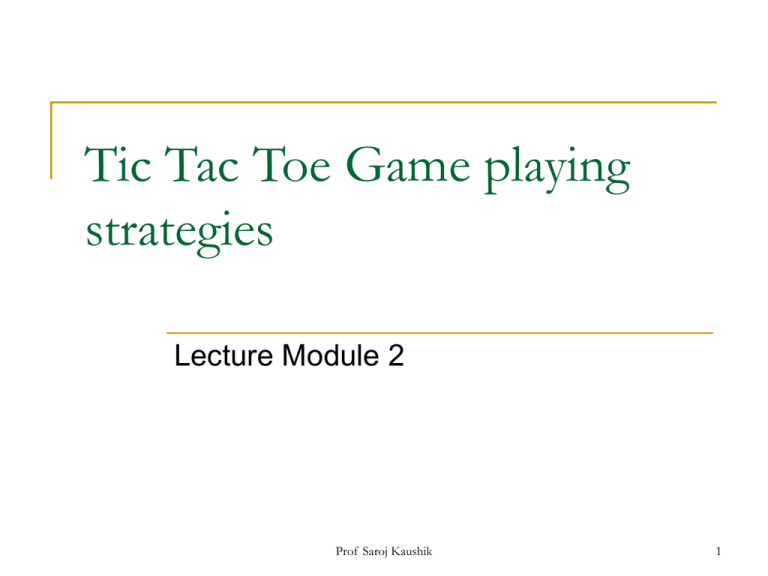
Tic Tac Toe Game playing
strategies
Lecture Module 2
Prof Saroj Kaushik
1
Tic–Tac–Toe game playing
Two players
human
computer.
The objective is to write a computer program in such
a way that computer wins most of the time.
Three approaches are presented to play this game
which increase in
Complexity
Use of generalization
Clarity of their knowledge
Extensibility of their approach
These approaches will move towards being
representations of what we will call AI techniques.
Prof Saroj Kaushik
2
Tic Tac Toe Board- (or Noughts and crosses, Xs and Os)
It is two players, X and O, game who take turns marking the
spaces in a 3×3 grid. The player who succeeds in placing three
respective marks in a horizontal, vertical, or diagonal row wins
the game.
1
2
3
4
5
6
7
8
9
Prof Saroj Kaushik
positions
3
Approach 1
Data Structure
Consider a Board having nine elements vector.
Each element will contain
● 0 for blank
● 1 indicating X player move
● 2 indicating O player move
Computer may play as X or O player.
First player who so ever is always plays X.
Prof Saroj Kaushik
4
Move Table MT
MT is a vector of 39 elements, each element of
which is a nine element vector representing
board position.
Total of 39 (19683) elements in MT
Index
Current Board position
New Board position
0
1
2
3
000000000
000000001
000000002
000000010
000010000
020000001
000100002
002000010
:
:
Prof Saroj Kaushik
5
Algorithm
To make a move, do the following:
View the vector (board) as a ternary number and
convert it to its corresponding decimal number.
Use the computed number as an index into the
MT and access the vector stored there.
●
The selected vector represents the way the board will
look after the move.
Set board equal to that vector.
Prof Saroj Kaushik
6
Comments
Very efficient in terms of time but has several
disadvantages.
Lot of space to store the move table.
Lot of work to specify all the entries in move table.
Highly error prone as the data is voluminous.
Poor extensibility
●
3D tic-tac-toe = 327 board position to be stored.
Not intelligent at all.
Prof Saroj Kaushik
7
Approach 2
Data Structure
Board: A nine-element vector representing the board:
B[1..9]
Following conventions are used
2
3
5
-
indicates blank
X
0
Turn: An integer
1
9
-
First move
Last move
Prof Saroj Kaushik
8
Procedures Used
Make_2 Tries to make valid 2
Make_2 first tries to play in the center if free and
returns 5 (square number).
If not possible, then it tries the various suitable
non corner square and returns square number.
Go(n) makes a move in square ‘n’ which is
blank represented by 2.
Prof Saroj Kaushik
9
Procedure - PossWin
PossWin (P) Returns
0, if player P cannot win in its next move,
otherwise the number of square that constitutes a
winning move for P.
Rule
If PossWin (P) = 0 {P can not win} then find
whether opponent can win. If so, then block it.
Prof Saroj Kaushik
10
Strategy used by PosWin
PosWin checks one at a time, for each rows
/columns and diagonals as follows.
If 3 * 3 * 2
= 18 then player X can win
else if 5 * 5 * 2 = 50 then player O can win
These procedures are used in the algorithm
on the next slide.
Prof Saroj Kaushik
11
Algorithm
Assumptions
The first player always uses symbol X.
There are in all 8 moves in the worst case.
Computer is represented by C and Human is
represented by H.
Convention used in algorithm on next slide
If C plays first (Computer plays X, Human plays O) Odd moves
If H plays first (Human plays X, Computer plays O) Even moves
For the sake of clarity, we use C and H.
Prof Saroj Kaushik
12
Algo - Computer plays first – C plays odd moves
Move 1: Go (5)
Move 2: H plays
Move 3: If B[9] is blank, then Go(9) else Go(3) {make 2}
Move 4: H plays
Move 5: {By now computer has played 2 chances}
If PossWin(C) then {won} Go(PossWin(C))
else {block H} if PossWin(H) then Go(PossWin(H)) else if B[7] is
blank then Go(7) else Go(3)
Move 6: H plays
Moves 7 & 9 :
If PossWin(C) then {won} Go(PossWin(C))
else {block H} if PossWin(H) then Go(PossWin(H)) else
Go(Anywhere)
Move 8: H plays
Prof Saroj Kaushik
13
Algo - Human plays first – C plays even moves
Move 1: H plays
Move 2: If B[5] is blank, then Go(5) else Go(1)
Move 3: H plays
Move 4: {By now H has played 2 chances}
If PossWin(H) then {block H} Go (PossWin(H))
else Go (Make_2)
Move 5: H plays
Move 6: {By now both have played 2 chances}
If PossWin(C) then {won} Go(PossWin(C))
else {block H} if PossWin(H) then Go(PossWin(H)) else
Go(Make_2)
Moves 7 & 9 : H plays
Move 8: {By now computer has played 3 chances}
If PossWin(C) then {won} Go(PossWin(C))
else {block H} if PossWin(H) then Go(PossWin(H)) else
Go(Anywhere)
Prof Saroj Kaushik
14
Complete Algorithm – Odd moves or even
moves for C playing first or second
Move 1: go (5)
Move 2: If B[5] is blank, then Go(5) else Go(1)
Move 3: If B[9] is blank, then Go(9) else Go(3) {make 2}
Move 4: {By now human (playing X) has played 2 chances} If
PossWin(X) then {block H} Go (PossWin(X)) else Go (Make_2)
Move 5: {By now computer has played 2 chances} If PossWin(X) then
{won} Go(PossWin(X)) else {block H}
if PossWin(O) then
Go(PossWin(O)) else if B[7] is blank then Go(7) else Go(3)
Move 6: {By now both have played 2 chances} If PossWin(O) then
{won} Go(PossWin(O)) else {block H} if PossWin(X) then Go(PossWin(X))
else Go(Make_2)
Moves 7 & 9 : {By now human (playing O) has played 3 chances} If
PossWin(X) then {won} Go(PossWin(X)) else {block H} if PossWin(O)
then Go(PossWin(O)) else Go(Anywhere)
Move 8: {By now computer has played 3 chances} If PossWin(O) then
{won} Go(PossWin(O)) else {block H} if PossWin(X) then Go(PossWin(X))
else Go(Anywhere)
Prof Saroj Kaushik
15
Comments
Not as efficient as first one in terms of time.
Several conditions are checked before each
move.
It is memory efficient.
Easier to understand & complete strategy has
been determined in advance
Still can not generalize to 3-D.
Prof Saroj Kaushik
16
Approach 3
Same as approach 2 except for one change
in the representation of the board.
Board is considered to be a magic square of size
3 X 3 with 9 blocks numbered by numbers
indicated by magic square.
This representation makes process
checking for a possible win more simple.
Prof Saroj Kaushik
of
17
Board Layout – Magic Square
Board Layout as magic square. Each row,
column and diagonals add to 15.
Magic Square
8
3
4
1
5
9
6
7
2
Prof Saroj Kaushik
18
Strategy for possible win for one player
Maintain the list of each player’s blocks in
which he has played.
Consider each pair of blocks that player owns.
Compute difference D between 15 and the sum of
the two blocks.
If D < 0 or D > 9 then
these two blocks are not collinear and so can be
ignored
otherwise if the block representing difference is
blank (i.e., not in either list) then a move in that
block will produce a win.
Prof Saroj Kaushik
19
Working Example of algorithm
Assume that the following lists are maintained up to
3rd move.
Consider the magic block shown in slide 18.
First Player X (Human)
8
3
Second Player O (Computer)
5
Prof Saroj Kaushik
20
Working – contd..
Strategy is same as in approach 2
First check if computer can win.
If not then check if opponent can win.
If so, then block it and proceed further.
Steps involved in the play are:
First chance, H plays in block numbered as 8
Next C plays in block numbered as 5
H plays in block numbered 3
Now there is a turn of computer.
Prof Saroj Kaushik
21
Working – contd..
Strategy by computer: Since H has played two
turns and C has played only one turn, C checks
if H can win or not.
Compute sum of blocks played by H
S = 8 + 3 = 11
Compute D = 15 – 11 = 4
Block 4 is a winning block for H.
So block this block and play in block numbered 4.
The list of C gets updated with block number 4 as
follows:
H 8 3
C 5 4
Prof Saroj Kaushik
22
Contd..
Assume that H plays in block numbered 6.
Now it’s a turn of C.
C checks, if C can win as follows:
Compute sum of blocks played by C
S=5+4=9
Compute D = 15 – 9 = 6
Block 6 is not free, so C can not win at this turn.
Now check if H can win.
Compute sum of new pairs (8, 6) and (3, 6) from the list of H
S = 8 + 6 = 14
Compute D = 15 – 14 = 1
Block 1 is not used by either player, so C plays in block
numbered as 1
Prof Saroj Kaushik
23
Contd..
The updated lists at 6th move looks as follows:
First Player H
8
3
Second Player C
5
4
6
1
Assume that now H plays in 2.
Using same strategy, C checks its pair (5, 1) and
(4, 1) and finds bock numbered as 9 {15-6 = 9}.
Block 9 is free, so C plays in 9 and win the game.
Prof Saroj Kaushik
24
Comments
This program will require more time than two
others as
it has to search a tree representing all possible
move sequences before making each move.
This approach is extensible to handle
3-dimensional tic-tac-toe.
games more complicated than tic-tac-toe.
Prof Saroj Kaushik
25
3D Tic Tac Toe (Magic cube)
All lines parallel to the faces of a cube, and all 4
triagonals sum correctly to 42 defined by
S = m(m3 + 1)/2 , where m=3
No planar diagonals of outer surfaces sum to 42.
so there are probably no magic squares in the
cube.
8
24
12 7
22 11
10
23
9
15 1 26
25 14 3
2
27 13
Prof Saroj Kaushik
19
5
18
17
21
4
6
16
20
26
8
24
10
15
1
26
19
17
6
12
22
7
11
23
9
25
2
14
27
3
13
5
18
21
4
16
20
8
24
12
7
22
23
11
9
15
14
2
26
3
27
13
19
17
5
6
21
4
• Magic Cube has 6 outer
and 3 inner and 2 diagonal
surfaces
1
25
18
10
16
• Outer 6 surfaces are not
magic squares as diagonals
are not added to 42.
• Inner 5 surfaces are magic
square.
20
Prof Saroj Kaushik
27


